Beacon Joe has returned from his shanty on the Rivers of America to continue a series started in OCTOBER 2008! Though much has changed since this article was written, you should read the first part of this series before continuing further….
Yes, I know. My blog posting frequency or (lack thereof) is absurd. Yet I feel that this series about nightlife at Walt Disney World is just as valid as it was when WDW execs decided to shutter Pleasure Island in late 2008.
Much has changed on the Island since last we spoke, most notably the additions of Ragalin Road (very popular) and right next door the monstrous T Rex (completing the bookend volcano look for Marketplace that goes so well with craftsmen architecture).
Good news is, no awful plan has come into place for Pleasure Island yet – we’ve got a giant balloon which seems rather unoffensive, and West Side is changing various third party forces – yet Pleasure Island seems more or less untouched at the moment.
So great! Let’s continue where we left off, shall we? In the first article I explained my opinion that the blandness of the Pleasure Island experience most likely lead to its downfall, but it provides an interesting template and supplies a necessary need for the Walt Disney World experience – nightlife! Walt Disney World seems to die off fairly early in the evening, and it’s fairly hard to find something to do into the wee hours of the evening, and I’d love to see that change. I’d love to see the unique Disney experience extend to adults who want to stay up and maybe enjoy a cocktail or two.
So instead of a sweeping armchair quarterback idea of a new themed nighttime district, I came up with a few essentials to what I think would work (and has already worked) to address this problem.
Back In Walt’s Day…. there was Disneyland
DISNEYLAND! Disneyland? Oh yes, there are Date Night at Disneyland and Disneyland After Dark specials I love, which show a hoppin theme park, with Louis Armstrong on the Mark Twain, and…. this….
Okay, so Bobby Rydell might not be the answer anymore, but perhaps keeping the parks open till a decent time might help. E Ticket nights were popular, as are the current extra magical hours. But even more intriguing about these specials is….
THE IMPORTANCE OF LIVE ENTERTAINMENT
Live entertainment works at Disneyland, and it hasn’t been working too great, or just as much, at Walt Disney World. Michael and I were shocked to see how many viable musical ensembles exist in Disneyland, most likely due to the difference in crowd perhaps (more local Annual Passholder folk). Even so, live entertainment – good, unique live entertainment, has been a Disney staple leading back to its formative days in Anaheim, where some of the first contractors were the Marching Band.
Frankie and the West End Boys covered Smashmouth, I’m more interested in these guys –
… and here’s a shiny example to show you I’m not all grumps. YeHaa Bob at the River Roost Lounge at Dixie Landings, or umm Riverside – is a glimpse into what I’m talking about. A more unique experience than listening to poor covers of Barenaked Ladies. There’s nothing too unique about that. To boot, at Disneyland, local or otherwise unknown bands often played and made waves on the national scene – including The Osmonds and No Doubt. Could there be a venue other than House of Blues for up and comers to play at Walt Disney World?
Story continues below the fold…
AN IMMERSIVE, TRANSPORTATIVE, HIGHLY THEMED EXPERIENCE
The drawing boards at Walt Disney Imagineering have been scattered through the years of wonderful themed ideas that have fallen by the wayside, and the nightlife sector is no exception. One good area to look at is the immersive restaurant concept, dating back to Walt Disney’s Enchanted Tiki Room. The entire Tiki Room concept came from the audio animatronic technology Walt was developing for a restaurant featuring birds, but it originally started as a Chinese Restaurant in a ne’er built section called Chinatown off Main Street featuring Confucius, or should I say “Grandfather Chung”.
A few years later, we see this concept come to life with the vultures at Club 33, which were intended to eavesdrop through microphones embedded in chandeliers and drop into conversations suddenly.
The Blue Bayou at Disneyland, the Phase 1 Magic Kingdom Restaurants (Liberty Tree, Cinderella’s Royal Table) and years later the restaurants at World Showcase provide unique dining experiences that remain incredibly popular with little change to this day. The Biergarten is a wonderful example of this, entering in to a controlled “nighttime environment,” an outdoor Octoberfest complete with nifty fake moon projection (look for it) and crazed live entertainment. We also see the faux nighttime effect at the Blue Bayou and San Angel Inn at EPCOT. These restaurants are always filled to the brim, and it’s because the experience is so different than going to a regular restaurant.
One doesn’t have to look far even today at Walt Disney World to see this working at night. Fort Wilderness’ Hoop Dee Doo Revue has been continually sold out on the same show since 1974, and the Polynesian Luau also continues to wow visitors, as it has for decades.
The Empress Lilly was once a unique experience like the ones mentioned before, until it was leased to Levy Restaurants to become Fulton’s Crab House. At one time it held several restaurants and lounges and was considered the crown jewel of Disney dining.
To supplement this pre-Michael Eisner’s arrival, Dick Nunis and Co. announced a New Orleans Street expansion where the Pleasure Island plot currently resides, with a New Orleans themed hotel (to later become Port Orleans) and a nighttime district extension of the Walt Disney World Village. I picture this being a smaller, more manageable area compared to the Pleasure Island/West Side sprawl – perhaps less clubby, and more of an extension of what’s now known as Marketplace, but with a little more adult/nighttime flair. Exquisetly themed, with a hotel option that would have no doubt been as popular if not moreso than the large resort it became. One can only imagine what might have been…
ENOUGH WITH THIRD PARTIES AND KEEPING EYES ON JONESES
The “unique/immersive” point leads me to one of my biggest gripes of the Eisner/Post-Eisner Era – cut it out with third party vendors! Okay, I’m not saying ALL third-party vendors – what would Walt Disney World be without the Arribas Brothers, and if Don DeFore’s Silver Banjo Barbeque ever came back to Disneyland, I’d be first in line. However, we’ve somehow gone from seemless blending of these third party folk to having them become the show, as was seen at Downtown Disney’s West Side development, and at the Boardwalk with such bland and non-Disney experiences as the Big River Grille, where you can find food and a micro brew experience just like you can in every town experiencing urban renewal.
Eisner’s looking around and keeping up with the Joneses mentality – to keep it hip, etc., led to hasty kneejerk planning such as Pleasure Island to combat Church Street Station, West Side to combat Universal’s City Walk, and the Disney-MGM Studios to combat the Universal Studios. Now we could waste our time debating the unique merits of each (in fact I may argue on all points that Disney’s answer is superior), but the point remains that all were reactionary decisions, and all are analogues to another entertainment option across town. Couldn’t Disney instead continue to provide the Disney Difference, not riffing with other folks’ plans and instead continuing to deliberately seek their own agenda?
WHAT ABOUT A DIVE?
Give the folks a comfortable place where they can drink and mingle I say. These days Walt Disney World bars have become homogenized and sterile – a sort of airport bar experience which I do not relish, including a menu of fixed drinks around property. Not too long ago, you could go to the Contemporary and order a “Monorail Pink”, “Monorail Yellow”, and “Monorail Red,” drinks specifically designed for the resort where the monorails came directly to the concourse. Now all the menus look the same, and there’s none of the intimacy, detail, and specific theming Disney is known for.
One of the most appealing concepts of Pleasure Island’s original plan never saw it off the drawing board. It was a bar called Madison’s Dive, which Jim Hill describes in an article you can read here as:
The nightclub that was originally announced for Disney’s World’s Pleasure Island but ultimately never built. The one that was supposed to have been loaded with all these salty old sailors who would win spin out these amazing yarns. The club that was to have had a sunken bar that featured a window that looked directly out into the depths of Lake Buena Vista. Where — every so often — a real live mermaid would have swum by the window.
Yes, Madison’s Dive would have been filled with some amazing effects, some of which ended up in the Adventurer’s Club. Alas, it too never saw the light of day, but I could imagine enjoying a place like that quite a bit. Smaller more intimate night experiences sound like a good idea to me.
SHOULD YOU SPREAD THE LOVE OR KEEP A SPECIFIC NIGHTTIME DISTRICT?
When Walt Disney World opened, nighttime entertainment was spread across property. It provided for more unique experiences, as you can still see with the Luau, Hoop Dee Doo, electrical water pageant, et al. Back in the 70s, you could also see Vegas-style entertainment with big names such as Rosemary Clooney and Mel Torme at the Contemporary’s Top of The World. It seemed Disney used all that was in its arsenal to provide a unique experience to visitors. As during the day, Disney planners at the time took advantage of the difference in the Florida counterpart to Disneyland, expanding entertainment to the resorts, on the water, and organized throughout property.
As the property expanded under the Eisner regime, it seemed the push to get Pleasure Island off the ground compromised other experiences. Even with the opening of the Boardwalk in 1996, the big brother status of Pleasure Island seemed to bully Boardwalk into never reaching its potential. Instead of expanding options around property and continuing to innovate, these execs seemed to feel the need to funnel people to one specific place to make it profitable. After the more-or-less shuttering of the Transportation and Ticket Center as a viable transportation hub in the mid-nineties, most nighttime busses crawled slowly through Downtown Disney in an effort to force folks to a corner of property they might not normally go to.
Instead of bus bamboozling, how about developing a product people will know about and want to go out of their way to see? I don’t really have an answer or fully developed opinion to this point, I don’t know if a giant nightclub district could ever be successful enough to compete fiscally with other products Disney offers – I do however believe that the Pleasure Island product itself could have been stronger, more unique, showcasing more Adventurer’s Club-like experiences instead of a pure street party appeal. Also I know that there should be nighttime experiences spread further across property – in the parks, at most resorts, and other places such as Boardwalk.
FOLKS NEED TO DANCE SOMEWHERE
Finally, the importance of cutting a rug must be addressed. Though not as imperative to social functions as it once was, according to my tally the only place you can dance around WDW now is in the little kid splash fountains in the theme parks and Atlantic Dance. This is unacceptable. Again looking back at Disneyland, the Plaza Pavilion once thrived as a dance venue, and working many a Grad Nite I can attest to the somewhat disturbing need for dance folks feel. I will say this – it may behoove Disney to aim small, miss small on this point. The Blessing of Size once again has come in to make WDW planners build giant sheds for folks to dance in – and though I love Atlantic Dance in theory – it’s just too big and most likely scares folks away with its largesse. All the clubs in Pleasure Island were huge (save 8 Trax and the Jazz Co,) and just might have been too big to be profitable.
I would love to see Pioneer Hall’s leger. The place is fairly tiny, the show has been the same for almost 40 years, yet they continue to charge so much money and keep up the popularity. Why? It’s intimate, it’s different, it’s themed, it’s worth all the money to see Disney working right. Where would you rather spend an evening – in the Wild West, or at a seedy dance club called Motion that feels a lot like a warehouse-turned-western saloon-turned-sketchy nightclub?
I know what I’d pick, and I believe I know what’s the smarter investment for decades to come…


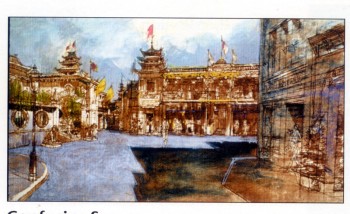
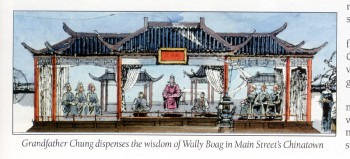
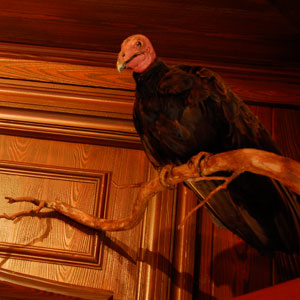
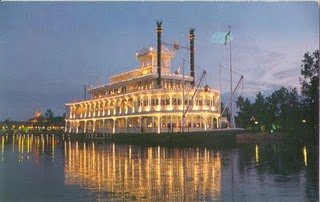
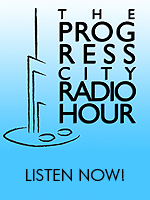





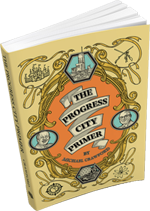

Two quick thoughts:
-Disneyland has the local LA talent pool to pull from. WDW has Orlando. This also contributes to the disparity between Disneyland and WDW both in terms of amount and quality of live entertainment.
-I can’t remember where I read this, but I do believe I remember that at the time of the PI closure announcement, it was strongly hinted at by someone in upper management that part of the reason for it was a desire to lose some of the crowds it attracted – as in a certain “type” of crowd. While I mourn the loss of the AC, if PI was in fact drawing a less savory crowd then closing it was the right answer. Disney having a clean, wholesome family image is far too important to sacrifice for nightlife. That said, I do agree that there ought to be a middle road where there are things to do late at night for adults. I think what you’ve suggested is a good starting point. I also think, as usual, Walt had it right. Date night at Disneyland would need some “generational translating” to work now, but late night, more “mature” (in the actual sense of the word) entertainment within the parks would be a huge hit I think – and park admission would probably keep out the “clubbers.”
Kudos, Beacon!
I read through post one and one surprised to see my comment stating that I couldn’t wait for part two.
Glad to see you back in the fold. I wonder if the 1970s WDW is lost to us forever and has become a “Mall of America” where they try to satiate the largest number of people. When I visited Disneyland in March 2008, I was astounded by the number of musical acts all over the place. I assumed that Disneyland caters to a much more local crowd, hence the need for a more varied entertainment offering. We all know that WDW lost a lot of its charm of being a vacation resort when Eisner built the place to fill the coffers. At that point, WDW became a mecca, or childhood (and parenthood) rite of passage.
Anyhoo, I love the idea of more localized entertainment that is spread throughout the property. My last trips to Downtown Disney with the family were almost strictly for DisneyQuest.
Mark and George – thanks for the replies…
There’s no doubt that the talent is richer in LA than Orlando (just compare the face characters in respective parks), but I imagine that the real reason we see less entertainment is the touristy transient nature of WDW’s crowd versus Disneyland’s more seasoned crowd. I know ex-WDW musicians that have been recruited nationwide and came to play, so I imagine the draw would be there to recruit plenty.
Now I do agree about the seedy underbelly PI was starting to draw, which made me reconsider whether or not WDW should have a club district at all. There were certainly many incidents in the PI/West Side parking lot during my stay down there and afterwards, and having a police watchstation at Disney seems to really break the illusion. It’s certainly not worth tarnishing the brand or image. This is why I think smaller, more resort/park inclusive entertainment would work better – you’d never see meth addicts trying to get some play at the Territory Lounge… but I digress.
I’ve just about given up on Downtown Disney at this point… can anyone cheer me up?
“I’ve just about given up on Downtown Disney at this point… can anyone cheer me up?”
Well, Downtown Disney Westside started life as a retail shopping mall that was to be anchored by the world’s largest Sears, at least THAT didn’t happen…
The old convention wisdom that “Disneyland is for locals and WDW is for vacationers” doesn’t really hold true anymore. For more than a decade everything WDW has done has been with the aim of turning guests into repeat visitors and shortening the time between trips: DVC, cheap motels, dining plans, special events (like marathons and Food festivals), etc. WDW has also radically narrowed their marketing focus from “the general public” down to families and Disney geeks*.
All of this means that WDW’s demographics are more like the Jersey Shore than they are a “dream vacation destination”. Those guests blowing it all on Johnny’s once-in-a-childhood trip are growing fewer in number while more and more guests are there on extended weekends and “we come to Disney World on my birthday every year”. Plus too, the average normal adult that was once attracted to real vacation activities like dining at EPCOT Center and the nightlife of Pleasure Island have been driven away by princess parties and the general branding of the entire property. People who aren’t interested in buying Nemo plush don’t have a lot to see at WDW these days.
WDW management hasn’t caught up to their changing demographic. It’s not exactly like Disneyland’s local, but it’s getting real close. Any show or attraction becomes stale after several repeat viewings; it’s the reason why Disneyland is continually tweaking their offerings and live entertainment. But that costs money and we know how WDW is with capital investment.
* – a big part of Pleasure Island’s decline and the failure of The Boardwalk really to take off is the dramatic fall of WDW’s convention business. As more princesses showed up, fewer dentist groups did – so WDW tried to compensate with even more princesses and so began a death spiral they haven’t pulled themselves out of yet.
GREAT article. Too bad Disney parks are DYEING. Breaks my heart. They’re becoming super-wal-marts which sell Disney junk with few attractions, diminishing EXPERIENCES. Almost nonexistant. Someone lost the eye on the ball. Very boring. Like to read about Disney and into parks, but my family doesn’t do WDW much anymore (and we live close, and used to work there). Very much in need of a new paradigm. Killing off stuff that doesn’t turn 1000% profit=unimaginative, and nighlife, food, service, experience for guests all suffer.
Castmember23 I could not agree more.
I used to love Walt Disney World, but I cannot stand what it is today.
Like you said….the parks are dying and I will go on to say that THEME PARKS are dying as well. The whole theme park experience, in my opinion, has burst its bubble.
The frustrating thing is that your read people’s comments on how much they dislike what is going on and it is from normal everyday people and not Disney dweebs.
I live in Florida and subscribe to the idea that the locals would come if you asked them to return again and again and showed them quality and a “FAMILY” experience, not a Pre-Kindergarten experience.
AV: THANK YOU… I’ve personally found the local argument to be a little convoluted myself, although it is true that Annual Passholders are so prevalent at DL. When I was working at WDW in 2000, Al Weiss told us one of their main focuses was to get more repeat visitors – and that in fact repeat visitors has increased exponentially since the Eisner-era expansion – hence their need to constantly rotate out attractions (see Future World).
Obviously, as I often complain, so much of their planning and results were so kneejerk, and a simpler solution may have been a better one. Instead of just gutting Future World attractions, later rehabs like Small World and Haunted Mansion show a much more responsible way of making the old seem new, while preserving the quality of something that you know works. Wouldn’t a better way to encourage repeat visitors NOT be to take away some of the most beloved attractions, but to slowly increase the experience, a la live entertainment, more unique dining options, etc? One can see from the success of Ohana alone (booking out 160 days in advance, etc.) that a cautious, steady eye on quality works more than NEW MANAGEMENT (Tiki Room, Journey Into YOUR Imagination).
I think some of the events work, and others make me sigh. The two EPCOT main events (Flower and Garden, Food and Wine) seem to use the park’s infrastructure properly and creatively and augment the EPCOT experience, while they also may provide an excuse not to add to World Showcase in and of itself, I don’t really know.
What I do know is that you all are right that the “Disney Parks” experience is being dumbed down to pirates and princesses, but other solutions are not that far away. One can look to California Adventure and see what seems to be more responsible planning going on, and after all, the somewhat hideous alleged “Night Kingdom” idea was suited specifically towards adults. While I’m glad that one didn’t make it off the drawing boards, I’m glad to know that that idea is floating around in the abstract.
In the face of all this, I choose to hope a bit that we can encourage Disney to make some good decisions – though the new Fantasyland will be mostly a Princess meet and greet, it will hopefully be pretty to look at and not have the Toontown tents anymore…. that alone makes me content to still care.
On Future World, all of the original EPCOT Center contracts required that each pavilion be completely revamped every ten years. Disney management at the time was very much aware of the “Tomorrowland Problem”; keeping the “future” in Future World was going to be doubly tough. That’s why all the main pavilions had so many film-based elements, so they could be continually updated to keep up with progress and why all of the ride systems were constructed to be so flexible and the show scenes so “stage-like”. The issue came that when 1992 rolled around, Eisner simply refused to spend anything on building new shows; the rehabs became bargain basements rehabs lacking the passion and talent which had gone into the previous shows. Things looked cheap and pathetic (and add to that Eisner’s low brow tastes – Bill Nye the Science Guy? – and fetish for cheap thrills his kids might like…things turned into a disaster).
Disneyland tried the overlay event route back in the 1970s and 1980s – ‘Blast to the Past’, ‘State Fair’, ‘Circus’ etc. It was thought to be a cheap way of keeping the locals interested, certainly cheaper than building new attractions. Pig racing in Frontierland, classic cars in Tomorrowland, the “Globe of Death” in front of the castle (it’s got to be on YouTube)…it didn’t work. Finally some brave soul, a Hero of True Disney, finally spoke up in a meeting and said the words no one wanted to admit: “People go to Disneyland to see Disneyland”. They learned their lesson, and recently had to relearn it with foolishness like ‘X-Games’ at California Adventure. The current events a Epcot are no where near the size, being little more than special merchandising events. They don’t cost all that much but they aren’t going to bring in throngs of DVC owners either.
There’s a reason Walt called it “plussing” and not “netting out to zero”. The way to get people coming back is to offer them MORE, yet WDW seems to think that somehow “different” drives repeat visitation. Ask anyone who runs a restaurant, just changing your menu gets a few curious visitors, but to keep people coming back you need to offer a better menu. Plastering Donald Duck over a filmstrip of Mexico isn’t going to entice me to visit but a new ‘Equatorial Africa’ pavilion will probably get me checking hotel rates on the Internet.
I think the issue is that WDW has been in crisis mode ever since they were forced to pay for buying ABC. Eisner/Iger mismanagement hasn’t stopped. WDW is being hurt by all the cutbacks, hacks and reductions they’ve done over the years to meet those financial demands. True, WDW has been hurt by 9/11 and the economy (which were not beyond what WDW has faced in the past), but the resort’s ability to deal with those issues had already been burned to pay for GO.com, Pixar, and Eisner’s bonus plan.
WDW management doesn’t know how to run the resort. People have been promoted for their ability to surrender to corporate demands than on their ability to run the business. WDW has lost focus on “the show” and so they have lost focus on the audience. And the guests see it and that’s why they are staying away in the millions.
Whether is an indian or italian wedding, we always pay attention to the smallest detail. When it comes to planning a party, all details are to be looked into with the outmost attention.